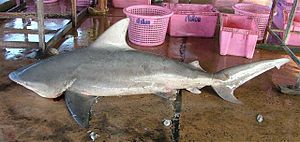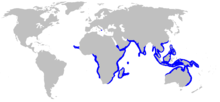Pig-eye shark
| Pig-eye shark | ||||||||||||
|---|---|---|---|---|---|---|---|---|---|---|---|---|

Pig- eye shark ( Carcharhinus amboinensis ) |
||||||||||||
| Systematics | ||||||||||||
|
||||||||||||
| Scientific name | ||||||||||||
| Carcharhinus amboinensis | ||||||||||||
| ( Müller & Henle , 1839) |
The pig's eye shark or Javahai ( Carcharhinus amboinensis ) is a species of the genus Carcharhinus within the Requiem sharks (Carcharhinidae). The distribution area of this species extends along the coasts of the Indo-Pacific, where it can be found off East Africa, Madagascar, South and Southeast Asia and Australia.
Appearance and characteristics
The pig-eye shark is a relatively large and compactly built shark with an average size of 200 to 220 cm and a maximum length of around 280 cm. He has a gray back without any noticeable markings and a white belly. There may be fin markings on the juvenile sharks, and a light flank stripe can appear on the flanks.
The shark's snout is very short and rounded, and the eyes are small. It has an anal fin and two dorsal fins . The first dorsal fin is comparatively large and sickle-shaped, it lies behind or directly above the rear attachment of the pectoral fins. There is no interdorsal ridge . The 2nd dorsal fin is small. The pectoral fins are relatively large and broad. Like all species of the genus, the animals have five gill slits and no injection hole .
It can be confused with the similarly large but less massive bull shark ( C. leucas ); it differs from this mainly in the different relative size of the dorsal fins.
Way of life
The pig-eye shark lives near the coast in the area of the continental shelf and on island bases at depths of up to 60 m. It feeds predatory, with small bony fish and various molluscs and crustaceans being part of its food spectrum. Potential competition probably exists with the similarly sized bull shark, since the pig-eye shark is rarer in areas where it is found.
Like other species of the genus, it is viviparous and forms a yolk sac placenta ( placental viviparous ). The young sharks have a size of about 70 centimeters, the animals reach sexual maturity with 195 cm (males) or 200 to 225 cm (females).
distribution
The range of the porpoise shark stretches along the coast of the Indo-Pacific . It occurs off the coasts of South and East Africa and Madagascar , as well as on the Asian coast from the Arabian Peninsula via India to Southeast Asia and the east coast of Australia . An isolated occurrence exists in the eastern Atlantic off the coast of Nigeria .
Importance to humans
No pig- eye shark attacks on humans are recorded in the International Shark Attack File . The shark is hunted for its meat and shark fin soup and in this way can be the carrier of the dangerous disease Ciguatera . In 1993, 98 people (out of more than 500 sick people) died in Madagascar after being infected by a pig-eye shark.
Danger
This species is occasionally fished with longlines and gill nets because of its meat and fins . In general, there is little quantitative data on catches of this species. In the Indo-West Pacific, a sporadic spread is reported. The data situation is better in South Africa, where a clear downward trend in catches is observed. Therefore, the IUCN has been issuing the status of potentially endangered for the population in the south-western Indian Ocean since 2009 .
From a global perspective, there is still a lack of data to assess the endangerment status of this species. This is why the pig-eye shark has the status insufficient data basis . But it is believed that this shark cannot withstand strong local fishing pressures.
literature
- Leonard Compagno , Marc Dando, Sarah Fowler: Sharks of the World. Princeton Field Guides, Princeton University Press , Princeton and Oxford 2005; Pp. 291-292. ISBN 978-0-691-12072-0
Web links
- Species portrait on hai.ch
- Pig-eye shark on Fishbase.org (English)
- Carcharhinus amboinensis inthe IUCN 2013 Red List of Threatened Species . Posted by: Cliff, G., 2005. Retrieved October 5, 2013.
Individual evidence
- ^ Gerhard G. Habermehl et al .: Severe ciguatera poisoning in Madagascar: A case report. ScienceDirect.com, December 1994, accessed September 10, 2013 .
- ↑ a b Carcharhinus amboinensis in the IUCN Red List of Threatened Species . Posted by: Cliff, G., October 11, 2005.
